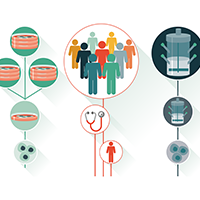A Bird’s Eye View: Current Bottlenecks and Future Opportunities in Bioprocessing
Cell Gene Therapy Insights 2018; 4(8), 777-779.
10.18609/cgti.2018.072
Cell and gene therapy is witnessing ‘interesting times’. What for the past two decades was an academia-based sector, is currently evolving into an up-and-coming, dynamic and multifaceted industry capable of delivering commercially viable solutions to patient populations in need. During these times, there are multiple debates at the strategic level to envisage how manufacturing might occur in the near future. Already, GMP-grade solutions allowing scalable production of ATMPs have entered the market, and solutions allowing automated manufacturing are increasingly being adopted by product developers and/or CMOs. Hence there is a gradual formation of ‘generic’ process pipelines that could be considered as blueprints for future production schemes. However, a degree of freedom to customize is and should remain key, since versatility in terms of product outlook – whether for a cell, gene or tissue product – is inherent in this field. What should be of utmost importance is the delivery of high-quality products with defined quality attributes that ensure functionality. In addition, future bioprocess pipelines should possess the capacity to deliver these products cost effectively which is a key element at this point of the field’s evolution.
In this special issue, a snapshot of current manufacturing challenges encountered for the production of several of these ATMPs is provided in an effort to see where synergies, or ‘particularities per product type’, might be found. Perspectives from both academic and industrial leaders hopefully provide a ‘bird’s eye view’ of both current bottlenecks and future opportunities.
In the Expert Insight article, Streamlining data management and process analytics for the manufacturing of cell and gene therapies, Dr Toon Lambrechts et al. (MyCellHub & Prometheus, KU Leuven) explore one such potential bottleneck: the need for data management strategies and technological solutions to deal with the huge surge in data derived from, and feeding into, advanced therapy manufacturing processes as they scale up and become more rigorous. The authors discuss paths forward to ensure this data is properly harnessed as an invaluable tool for future bioprocess design and control.
The theme of bioprocess scale-up is continued by Dr Lior Raviv (Pluristem) in Changing the “art” of growing cells into an industrialized platform for marketing scale manufacturing. Dr Raviv focuses on the core elements of bioprocessing which must evolve to deliver the required quality and consistency demanded by mature commercial sectors such as protein therapeutics.
Jacob Smith et al. (AskBio) shift focus to AAV vector bioprocessing in ‘Overcoming bottlenecks in gene therapy manufacturing’. Perhaps no other specific technology area within cell and gene therapy currently incorporates such a pressing need for technological innovation – in this case, to swiftly alleviate a severe capacity crunch while simultaneously driving quality improvements in a field newly experiencing the sort of regulatory stringency one expects at the commercial product level.
Next-generation stem cell expansion technologies by Dr Carlos AV Rodrigues et al. (Institute of Bioengineering & Biosciences, Istituto Superior Tecnico, University of Lisbon) examines recent advancements in bioreactor design and configuration, with a view to defining optimal approaches towards delivering the ‘Holy Grail’ of combined quality and consistency in stem cell expansion. In this perspective article, the authors provide an exploration of bioreactor miniaturization, and of the pros and cons of different culture formats (microcarriers vs cell aggregates).
The tissue engineered product field’s struggles in achieving lasting commercial success have resided in part in a failure to develop cost-effective, automated and standardized manufacturing processes. In Automated tissue manufacturing through 3D bioprinting, Dr Fabien Guillemot et al. (Poietis) assess the potential of a disruptive technology area at the intersection of automation, biology and digital technology to create a bright future in an area that is one of cell and gene therapy’s pillars – indeed, its former standard bearer.
In our interviews section, VRL Eurofins examine the various types of lab testing needed to mitigate risk and ensure safe and efficacious cell and gene therapy products, including infectious disease screening of donors for transplantation, microbiological testing for cells, tissues and patients prior to transplant, and immunogenetics. Eppendorf discuss lessons learned from more mature biologics sectors that can be applied to cell therapy bioprocessing and look at how to address current bottlenecks in scaling up to cost-effective commercial manufacture.
financial & competing
interests disclosure
The author has no relevant financial involvement with an organization or entity with a financial interest in or financial conflict with the subject matter or materials discussed in the manuscript. This includes employment, consultancies, honoraria, stock options or ownership, expert testimony, grants or patents received or pending, or royalties. No writing assistance was utilized in the production of this manuscript.
We hope you enjoy reading this spotlight dedicated to the advances in bioprocessing of cell and gene therapies – and look forward to your feedback and discussion.
Affiliation
Ioannis Papantoniou1,2
1 Prometheus the division of skeletal tissue Engineering KU Leuven
2 Skeletal Biology and Engineering Research Centre, KU Leuven
This work is licensed under a Creative Commons Attribution- NonCommercial – NoDerivatives 4.0 International License.

